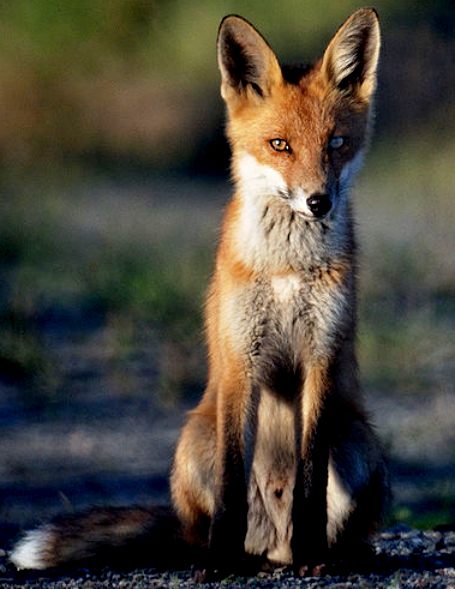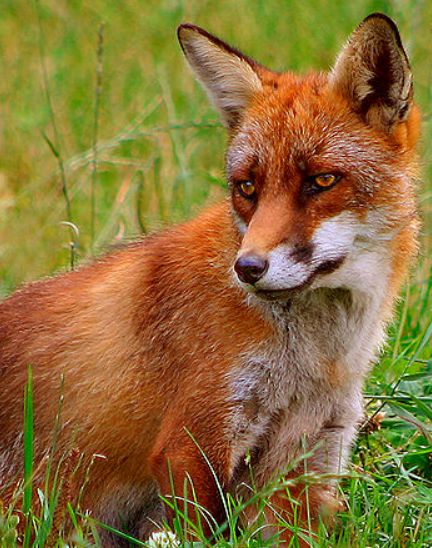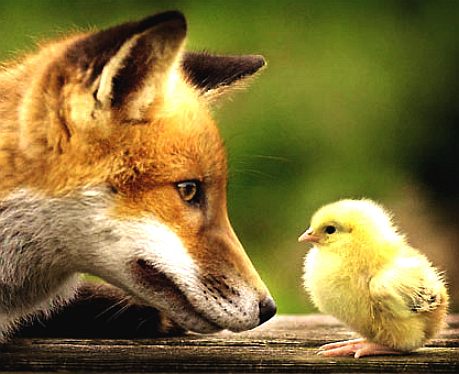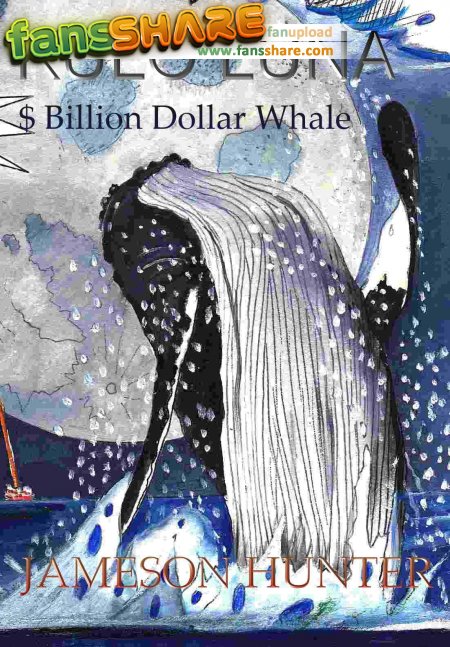FOXES
As cunning as a fox. How often have you heard that? These adorable animals are part of English folklore. They bring the countryside to life. They do though smell and give a nasty bite if cornered in the wild. But then, so do many animals. The fox is adaptable and shy, but it has to be relatively street wise to survive - hence, it is cunning.
For a few years a fox slept in the back yard at the Museum at Herstmonceux. Nobody invited it, it invited itself, a bit like the peacocks that invited themselves a few years before. The fox liked the peace and quiet and could sunbathe where once bonfires has been lit, among the concrete bases of the old generating machinery. We did not have the heart to disturb him, leaving him to his slumbers. He was though a bit old, and we have not seen him this year (2013), so, we must think the worst.
'Fox' is
the common name for many species of alert omnivorous mammals belonging to the Canidae family. Foxes are small-to-medium-sized canids (slightly smaller than a medium-sized domestic
dog), with a flattened skull, upright triangular ears, a pointed, slightly upturned snout, and a long bushy tail (or brush).
Members of about 37 species are referred to as foxes, of which only 12 species actually belong to the Vulpes genus of "true foxes". By far the most common and widespread species of fox is the red fox (Vulpes vulpes), although various species are found on almost every continent. The presence of fox-like carnivores all over the globe, together with their widespread reputation for cunning, has contributed to their appearance in popular culture and folklore in many societies around the world (see also Foxes in culture). The hunting of foxes with packs of hounds, long an established pursuit in Europe, especially the British Isles, was exported by
European settlers to various parts of the New World.
LIFESTYLE
In the wild, foxes can live for up to 10 years, but most foxes only live for 2 to 3 years due to hunting, road accidents and diseases. Foxes are generally smaller than other members of the family Canidae such as wolves, jackals, and domestic dogs. Male foxes are called Reynards, and weigh, on average, around 5.9 kilograms (13 lb) while female foxes, called vixens, weigh less, at around 5.2 kilograms (11.5 lb). Fox-like features typically include a distinctive muzzle (a "fox face") and bushy tail. Other physical characteristics vary according to habitat. For example, the fennec fox (and other species of fox adapted to life in the desert, such as the kit fox) has large ears and short fur, whereas the
Arctic fox has tiny ears and thick, insulating fur. Another example is the red fox which has a typical auburn pelt, the tail normally ending with white marking. Litter sizes can vary greatly according to species and environment – the Arctic fox, for example, has an average litter of four to five, with eleven as maximum.
Unlike many canids, foxes are not always pack animals. Typically, they live in small family groups, and are opportunistic feeders that hunt live prey (especially rodents). Using a pouncing technique practiced from an early age, they are usually able to kill their prey quickly. Foxes also gather a wide variety of other foods ranging from grasshoppers to fruit and berries. The gray fox is one of only two canine species known to climb trees; the other is the raccoon dog.
Foxes are normally extremely wary of humans and are not usually kept as indoor pets; however, the silver fox was successfully domesticated in Russia after a 45-year selective breeding program. This selective breeding also resulted in physical and behavioral traits appearing that are frequently seen in domestic cats, dogs, and other animals, such as pigmentation changes, floppy ears, and curly tails.
FEEDING
Foxes are omnivores. The diet of foxes is largely made up of invertebrates and small mammals, reptiles (such as snakes), amphibians, scorpions, grasses, berries, fruit,
fish,
birds, eggs, dung beetles, insects and all other kinds of small animals. Many species are generalist predators, but some (such as the crab-eating fox) are more specialist. Most species of fox generally consume around 1 kg of food every day. Foxes cache excess food, burying it for later consumption, usually under leaves, snow, or soil.
FOX HUNTING
Fox hunting is an activity involving the tracking, chase, and sometimes killing of a fox, traditionally a red fox, by trained foxhounds or other scent hounds, and a group of unarmed followers led by a master of foxhounds, who follow the hounds on foot or on horseback.
Fox hunting originated in the form practised until recently in the United Kingdom in the 16th century, but is practised all over the world, including in
Australia, Canada, France,
Ireland, Italy and the
United
States. In Australia, the term also refers to the hunting of foxes with firearms similar to spotlighting or deer hunting. In much of the world hunting in general is understood to relate to any game animals or weapons (e.g., deer hunting with bow and arrow); in Britain and Ireland, "hunting" without qualification implies fox hunting (or other forms of hunting with hounds-beagling, stag hunting, mink hunting, drag hunting or hunting the clean boot) as described here.
The sport is controversial, particularly in the UK, where it was banned in
Scotland in 2002, and in England and Wales in November 2004 (law enforced from February 2005), though shooting foxes as vermin remained legal. Proponents of fox hunting view it as an important part of rural culture and useful for reasons of conservation and pest control, while opponents argue that it is cruel and unnecessary.
JUNK SCIENCE
A bespectacled ornithologist took the stand at Brighton Magistrates Court on Monday the 23rd of September 2013 and told District Judge Stephen Nicholls that lapwings were plentiful at Pevensey Levels in East Sussex. This is effect meant that he was reaffirming the scientific (SSSI) designation for the Pevensey area, when notified in 1977 and then again 1990.
Natural England had decided to prosecute a landowner who, it appears from a TV broadcast, had generated racial feelings of discontent in the Wartling locality due to his flamboyant style. The landowner had gained planning consent to improve a pond, which attracted ducks and other wildfowl. Cath Jackson and Sue Beale were sent in to investigate, but not to look at whether or not the SSSI was still valid, more to see if a technical conviction could be obtained to appease local rantings, by then supported by MP Greg Barker. The main issue in contention was to do with fencing, which Allan Drewitt claimed would affect the decision of lapwings to nest in the area. This is course presumes that lapwings do nest in this particular neck of the woods.
Barrister Jonathan Mitchell and solicitor Andrew Hopkin were employed by Natural England, despite the fact that they practiced well and truly outside the county - all adding to the potential costs. Mitchell questioned Drewitt in the absence of the landowner, who was not in a fit state to attend court. Despite this, Stephen Nicholls insisted on hearing the case, dismissing another case that was in a state of readiness and also granting another case where a defendant was ill, a stay. Our question here is: why allow one defendant a stay for sickness and not another? Another question would be: why dismiss a case that was ready, in preference for hearing a case where the defendant was not fit to attend court? The only answer that comes to mind is that Judge Nicholls was hell bent on ruling in the Natural England case. For otherwise it appears irrational, illogical or even perverse. This little twist adds to the racial element, by way of discrimination, where a court is duty bound to ensure a defendant receives a fair hearing.
One of our operatives is familiar with the area and knew that lapwing nesting had declined to very low levels. The decline is mainly due to the new fondness for the area (another story) of magpies and foxes, possibly with a little global warming thrown in for good measure. Both species thrive on eggs and the hatchlings of anything on the marshes. In the opinion of our local man, a lapwing would need to be suicidal, or otherwise desperate to consider this area as a winter home, when there are more hospitable areas in the west country - which is the more normal location for wintering plovers.
On examination by Judge Nicholls, Allan Drewitt admitted a decline in numbers from 6,000 in 1990 to 3,500 in 2008. Mr Drewitt, a short man of slight build, said there were no up to date bird figures that he could give the court. To our mind that was a cop out, where it is alleged that Natural England are no longer keeping figures up to date because they know the decline would declassify this area in terms of lapwings - which of course means that fences would no longer be an issue - hence no prosecution would be possible.
In any event it turned out the fencing was in response to uncontrolled flooding by the Environment Agency, the fencing to protect and control livestock that did not take kindly to wading and would flee potentially causing accidents. The flooding was of course ignored by Natural England, where they knew the marsh was drying up, and hoped to artificially keep the land attractive to waders. Thus the cause of at least one of the issues, appears to have been Natural England, for not prosecuting the agency causing the flooding.
If that is so and Natural England knew it, then the evidence that was tendered in Court, was not accurate, which may fall to be considered as a 'failure to advise', or in the case of a criminal prosecution such as this; could come under the heading of perjury or even fraud - as per Section 2,3 and 4 of the Fraud Act 2006.
POPULAR MAMMALS:
|
Antelope Cat - Domestic |
Leopard |
Index to navigate Animal Kingdom:-
|
LINKS
http://en.wikipedia.org/wiki/Lapwing
A heartwarming adventure: Pirate whalers V Conservationists,
with an environmental message.
For release as an e-book in 2013 with hopes for a film in 2015 TBA
(graphic design: Martin House)
This website is Copyright © 2013 Electrick Publications & Blueplanet Universal Productions.
The bird logos and name Solar Navigator are trademarks. All rights reserved. Max Energy Limited is an educational charity working hard for world peace
|
BLUEBIRD | BLUEFISH | BLUEPLANET BE3 | FORMULA E | SOLARNAVIGATOR | UTOPIA |



